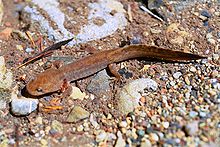California giant salamander
| California giant salamander | |
|---|---|
 |
|
| Scientific classification | |
| Kingdom: | Animalia |
| Phylum: | Chordata |
| Class: | Amphibia |
| Order: | Caudata |
| Family: | Dicamptodontidae |
| Genus: | Dicamptodon |
| Species: | D. ensatus |
| Binomial name | |
|
Dicamptodon ensatus (Eschscholtz, 1833) |
|
The California giant salamander (Dicamptodon ensatus) is a species of salamander in the family Dicamptodontidae. It is endemic to California, in the western United States. The species name once additionally included individuals now belonging to the species D. aterrimus (Idaho giant salamander) and D. tenebrosus (coastal giant salamander), under the common name Pacific giant salamander, which now refers to the genus and family.
The Pacific giant salamander (D. ensatus) was thought to consist of three geographic populations, an Idaho isolate, a group in northern California and a group in Oregon and Washington. In 1989 genetic studies showed that the D. ensatus populations consisted of three subspecies: the Idaho giant salamander (Dicamptodon aterrimus) in Idaho, and two highly divergent species with a narrow hybrid zone in California, the coastal giant salamander (Dicamptodon tenebrosus) (ranging from northern California to Washington) and the California giant salamander (Dicamptodon ensatus) (ranging from Santa Cruz County to Mendocino County). A fourth species of Dicamptodon, Cope's giant salamander (D. copei), lives on the Olympic Peninsula, Washington.
Its natural habitats are temperate forests, rivers, freshwater lakes, and freshwater marshes.
...
Wikipedia

